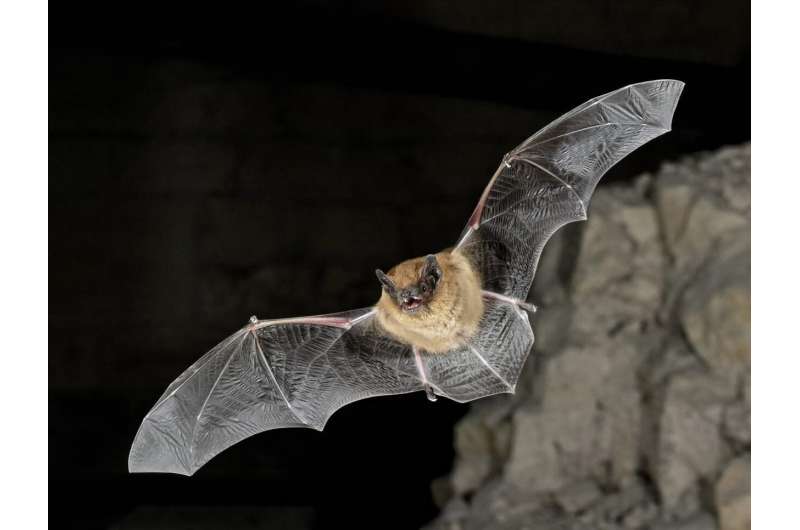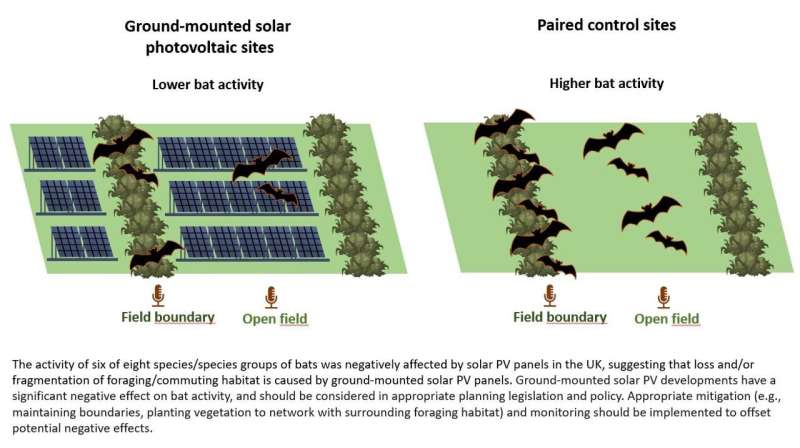This article has been reviewed according to Science X's editorial process and policies. Editors have highlighted the following attributes while ensuring the content's credibility:
fact-checked
peer-reviewed publication
trusted source
proofread
Bat activity lower at solar farm sites, study finds

The activity level of six bat species was significantly reduced at solar farm sites, researchers have observed.
Their findings, published today in Journal of Applied Ecology, have the potential to impact and inform planning legislation and policy so that the benefits of solar power are reaped without impacting wildlife.
Renewable technologies are important in meeting energy demands sustainably. This is of vital importance given the roles of fossil fuels in producing carbon dioxide, a key driver of climate change. Renewable energy is growing at a rapid pace globally, with solar photovoltaic power providing about 30% of global renewable power, and having increased in amount by 25% in 2021.
Lead author Lizy Tinsley from the University of Bristol's School of Biological Sciences explained, "Renewable energies can have negative impacts on biodiversity and mitigation is essential to provide win-win solutions for energy suppliers and for wildlife."
To carry out their experiment, the team set up bat static monitoring equipment in a solar farm field, and a matched field without solar panels (control site).
Fields were matched in size, land use, and boundary feature (e.g. hedge, fence, stream), and a bat detector was placed in the middle and edge of both fields, totaling four recording locations, repeated across 19 separate sites. Field boundaries were selected as they are important navigation features for bats.
The data from the different echolocation calls at recording points were then analyzed to identify the bat species and number of bat passes. They found that the activity level of common pipistrelle, noctule, myotis species, serotine, soprano pipistrelle and long-eared species was substantially lower at solar farm sites, compared to the paired control sites.

Lizy said, "Due to the significant negative impact identified, solar farm developments should be screened in an Environmental Impact Assessment for ecological impacts so that appropriate mitigation be designed against the impacts, and monitoring undertaken. This has already been done with wind farms—where mortality of bats has been reduced by changing the wind speeds at which turbines become operational and by using acoustic deterrents, at minimal cost.
"Further research is required to assess bat behavior at solar farms, and why it is causing the significant decrease of certain species at the site. Is it the loss of suitable habitat that reduces activity? Are they fewer insect prey available, and are bats at risk of collisions with panels?
"It will be important to identify mitigation strategies that can benefit bats at solar farms, such as planting insect-friendly plants, providing corridors to insect-rich habitats, or providing suitable alternative foraging habitats such as trees. Mitigation strategies can potentially mean that renewable energy can be provided while simultaneously having no detriment to wildlife. Such mitigation will be critical in reaping the undoubted benefits for climate change that can be provided by renewable energy."
Co-author Professor Gareth Jones added, "This is novel research, as the impacts of solar farms on wildlife are currently little understood, with no evidence regarding their effects on bats, which can provide valuable ecosystem services such as the suppression of pest insect populations.
"The situation is potentially of concern as solar farms are occupying increasing areas of suitable foraging area for bats, and we already know that bats can collide with vertical flat surfaces, and can mistake flat surfaces for water, and attempt to drink from them. Very little is known on the impacts of solar farms on bat, particularly in the UK."
The team now plan to look at the differences in invertebrate species richness and abundance between the paired sites.
More information: Renewable energies and biodiversity: impact of ground-mounted solar photovoltaic sites on bat activity, Journal of Applied Ecology (2023). dx.doi.org/10.1111/1365-2664.14474
Journal information: Journal of Applied Ecology
Provided by University of Bristol



















